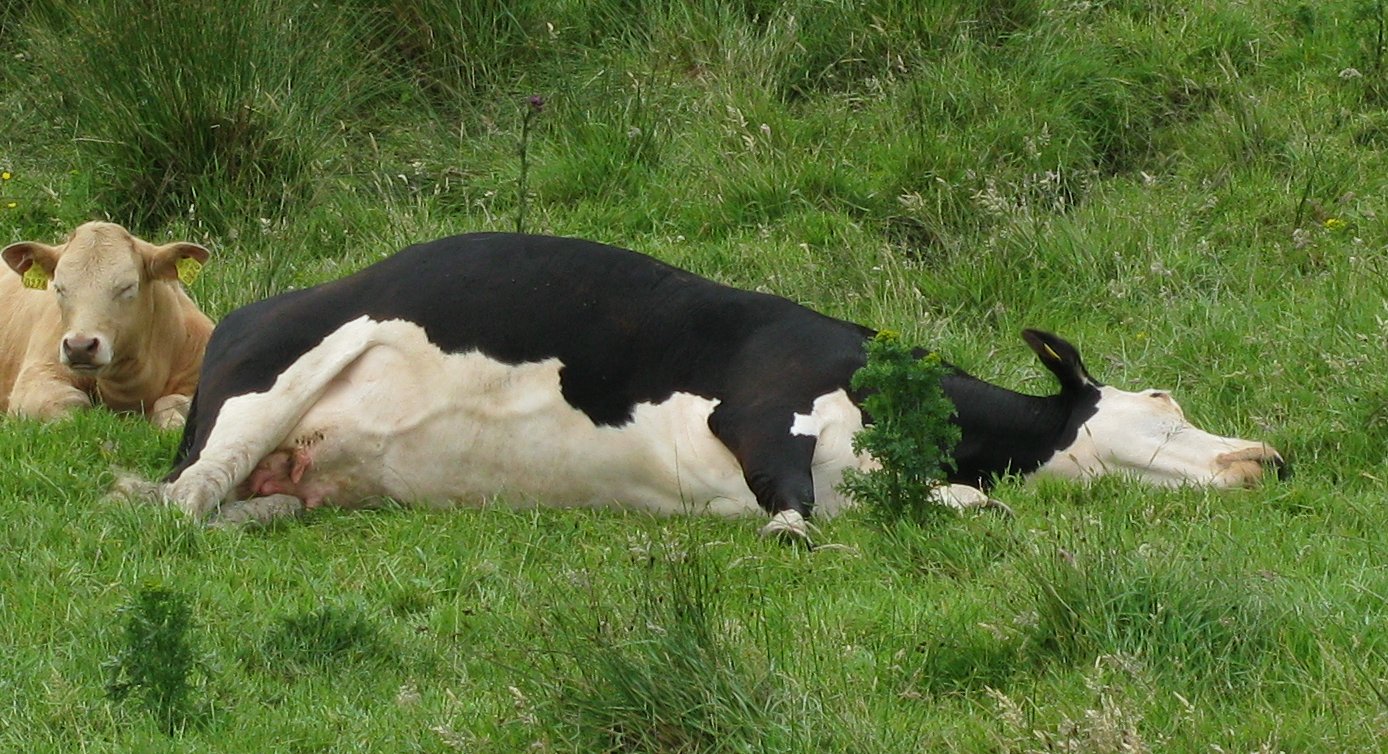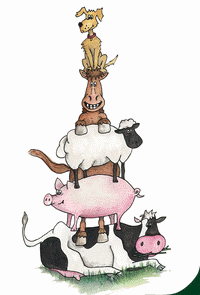Show all large animal articles
Management and treatment of the down cow
Matt Swanborough MRCVS, Veterinary Advisor for Norbrook Laboratories - 14/03/2018
Management and treatment of the down cow
A downer cow, often referred to as a down cow, can be one of the most rewarding ‘easy fixes’ or one of the most frustrating cases you deal with in practice. Regardless of the circumstances, swift decision and action is key. It is important to act quickly to resolve the cause, and provide suitable subsequent care.
What is a downer cow?
A downer cow is poorly defined; however, the generally accepted term is a cow that is recumbent and unable to get up for more than 24 hours after the initial cause is identified and resolved. The key is to act swiftly and confidently to lower the risk of ‘downer cow syndrome’ – firstly resolve the cause, and then care for the cow. NADIS (2018) maintains that ‘good nursing care, is often the key to success’.

Timings and impact
The length of time that a cow remains down is a critical factor in terms of prognosis; in short, the longer the cow is down, the less likely she is to rise again due to muscle and nerve damage. A study by Fenwick et al.,(1986), investigated key time periods and their implications. These are summarised as below:
|
≤6 hours |
After as little as six hours down, the cow begins to damage its muscles, nerves and joints due to its bodyweight. It is important to act within this time if possible: Fenwick et al., (1986) reported that only two per cent of dairy cows treated for milk fever within six hours became downer cows. |
|
7 to 12 hours |
With cows not treated for seven to 12 hours, more than 25 per cent became downer cows. |
|
≥18 hours |
Nearly 50 per cent of cows not treated until after 18 hours were reported as being unable to rise. |
Causes:
There are several possible reasons a cow may become recumbent, which can be established by the animal’s history and a thorough clinical examination. You need to ask the farmer for as much information as possible with regard to calving, length of recumbency, treatment and medical history. However, it is important to remain clear-headed and objective when approaching diagnosis: don’t let a farmer’s opinion sway you prior to gathering all the information for yourself and coming to your own conclusion.
Often the cause can be categorised into one of the following:
|
|
|
Treatment of initial cause of recumbency |
|
Metabolic imbalances |
The most common cause of downer cow syndrome is a complication of periparturient hypocalcaemia in cows that do not fully respond to calcium treatment (Constable, 2017). This can either be due to inappropriate/insufficient dosing or concurrent conditions such as hypophosphatemia or hypomagnesemia. Consider taking a blood sample before administering any treatment in case further metabolic profiling becomes necessary. |
Hypocalcaemia – administration of a suitable calcium product. IV administration will act the quickest, but other routes (subcutaneous or bolus) will provide a longer duration of action. Hypophosphatemia – Administration of a suitable phosphorus product where appropriate will address any deficiencies as well as synergistically assisting calcium treatment. |
|
Trauma |
Calving paralysis due to periparturient nerve trauma after calving is another common cause, but it is important not to rule out bulling injuries or severe fractures. |
NSAID treatment should be considered to assist in the reduction of any inflammation that may have occurred. |
|
Disease |
Toxaemia as a result of mastitis, metritis and other toxicities can be a cause of downer cows (Blowey and Weaver, 2008). Other diseases that can cause cows to go down include uterine infections, Johne’s disease, polio and chronic pneumonia.
|
Use of a suitable antibiotic, if appropriate. The use of the NSAID flunixin will assist in treating any pyrexia associated with infection, as well as reducing the effects of further toxaemia. Fluid therapy should also be considered (IV and/or oral rehydration). |
Once a cause has been identified is important that labour costs (if relevant) and the cow’s prognosis be assessed before determining how to proceed.
Continued management and treatment:
Regardless of the initial cause for recumbency, while a cow is down she develops pressure myopathy due to her own bodyweight - therefore swift and efficient management of these downer cows is crucial. Additional complications of recumbency can include acute mastitis, pressure necrosis or ulcers and further traumatic injuries to her limbs from attempts to rise.
- As already discussed, downer cows are often hypocalcaemic, however, when she fails to respond to treatment, monitoring blood minerals is essential for management. This is when a blood sample taken before metabolic treatment can be useful. A cow can be additionally supplemented with other metabolic therapies as appropriate.
- Food and water must be within a cow’s range, and it is important to ensure, if she isn’t penned alone, that other cows aren’t eating and drinking her supply. If she is not drinking by herself, continued fluid therapy should be considered.
- The cow must also be moved frequently and assisted, with particular attention paid to the hindlimb she is laying on. In order to prevent ischemia, the cow should be rolled from one side to the other every three hours.
- Where possible, consider lifting the cow and supporting her weight while she stands. Using a chest strap as well as hip clamps will help prevent further trauma.
- If not already being used, NSAIDs can help target anti-inflammatory actions of downer cow syndrome, as well as making the cow more comfortable.
- If the cow is lactating she must be milked if down for more than 12 hours to reduce mastitis risk.
- Attention must be paid to a cow’s body temperature: if an inactive animal becomes cold, hypothermia can set in and shock can become worse. Protect the cow from wind and rain and use straw bedding for insulation.
Prevention:
Once the cow in question has been treated, there may arise the opportunity to advise on a prevention strategy for the future. While the general range of broader recommendations on herd health management, such as ongoing observation and early treatment of disease can be applied, there are some particular measures that could be considered with regard to lowering the risk of downer cows, specific to the cause of the cow in question.
For a cow that has gone down through metabolic imbalances, for example, it may be appropriate to discuss mineral provision with the farmer. Some incidences of downer cows can be prevented through appropriate supplementation. Magnesium should be supplemented around calving time, while calcium should be added to a dairy cow diet with caution; over-supplementation of calcium before calving can increase the risk of milk fever.
Instances where cows have experienced trauma may present the opportunity to discuss best practice measures associated with handling and facility maintenance, in order to lower the risk of future preventable injuries.
This article is kindly provided by Norbrook Laboratories and was written by Matt Swanborough MRCVS, Veterinary Advisor for Norbrook Laboratories.

Blowey, R. and Weaver, A. (2008). Color atlas of diseases and disorders of cattle. London: Mosby.
Constable, P. (2017). Overview of Bovine Secondary Recumbency - Musculoskeletal System - Veterinary Manual. [online] Veterinary Manual. Available at: http://www.msdvetmanual.com/en-gb/musculoskeletal-system/bovine-secondary-recumbency/overview-of-bovine-secondary-recumbency [Accessed 1 May 2017].
Fenwick DC, Kelly WR, Daniel RCW. (1986). Definition of nonalert downer cow syndrome and some case histories. Vet Rec 1986; 118:124–128.
NADIS (2018) Downer Cow. [Online] Available at: http://www.nadis.org.uk/bulletins/downer-cow.aspx. Accessed February 2018.

